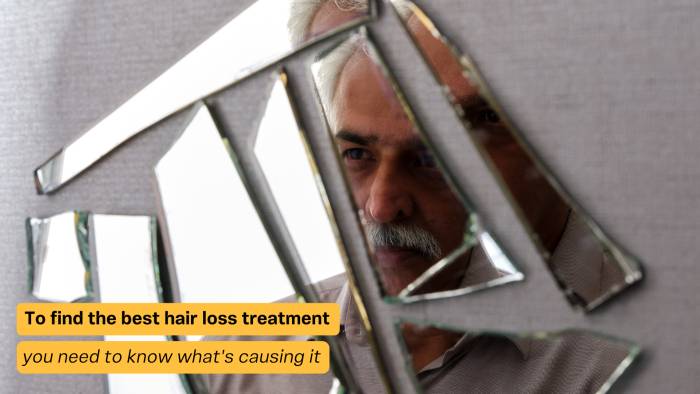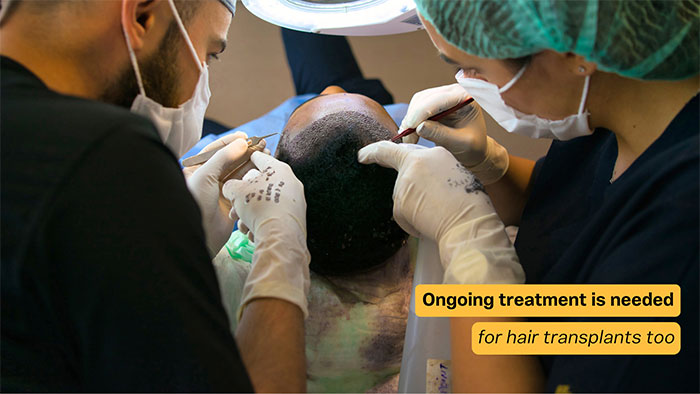Hair loss can happen to anyone.
Article by Nerissa Bentley, The Melbourne Health Writer
Around 50% of men show signs of balding by the time they’re 501, with 80% experiencing male pattern baldness by the time they’re 80 years old2. About half of women will be affected by female pattern hair loss3.
If you’ve noticed a receding hairline, hair thinning or other signs of balding, you may be wondering what you can do about it. Thankfully, there are a range of different treatments available to address the many causes of hair loss.

What causes a receding hairline?
To find the best hair loss treatment for you, you’ll need to know what’s causing your condition. Hair loss can be a result of many things including hormonal changes and medical conditions. Androgenic alopecia is one of the most common hereditary hair loss conditions in which the hormonal imbalances affect the hair follicles. Often, this genetic condition can work in combination with other factors to cause balding.
Hair loss treatments
Depending on what’s causing of your hair loss, and how advanced your condition is, there are a number of treatments that a medical professional may recommend to stimulate hair regrowth or at least, slow down and stop the progression of hair loss.
When choosing a treatment plan, it’s important to note that no treatment, including surgical procedures are a permanent fix, so it’s always important to find something that offers ongoing support.
Topical hair loss treatment
Topical hair loss treatments can contain medication to increase the flow of nutrients, blood supply and oxygen to the hair follicles to encourage hair growth.
Topical treatments may or may not require a prescription, depending on the strength of the product, and can come in liquid, foam and shampoo formulations. These products should be applied to a clean, dry scalp before any other hair products are used.
Before using any topical solution, it’s important to be aware of the active ingredients. Some solutions are not suitable if you’re pregnant or breastfeeding and if you have low blood pressure or take blood pressure medication. Other over-the-counter treatments may be less likely to be effective. Always check with an experienced hair loss doctor or trichologist before using any topical hair treatment.
Oral treatment for hair loss
If topical treatments aren’t effective, dihydrotestosterone (DHT) blockers and androgen blockers may be necessary. Taken as oral medication, they work by blocking the action of enzymes that change androgen hormones (including testosterone) into another hormone called DHT4.
High levels of androgens and DHT can shrink your hair follicles and shorten the hair growth cycle. This causes hair to grow thin and brittle. When these hairs fall out, follicles take longer to grow which contributes to balding.
Your hair loss specialist may recommend use of these medications in combination with other treatments for best effects.
Oral medications for hair loss are not suitable for everyone, particularly those with a history of heart problems, kidney problems, or liver issues5. They’re also not suitable for pregnant women, women who may become pregnant and those who are breastfeeding6.
Laser hair loss treatment
Low-level laser therapy (LLLT) is another non-invasive treatment that is suitable for both men and women of all ages.
Hair growth involves three cycles: a growth phase, a resting phase and a shedding phase. Laser therapy works by increasing blood flow in the scalp and stimulating metabolic processes for hair growth in the resting and shedding phases. It also prevents excessive build-up of DHT 7.
Laser therapy shouldn’t be used if you are taking medications that cause your skin to be extra sensitive to sunlight (photosensitising medications), so speak to your doctor first.

Hair transplants
Surgical hair restoration (aka hair transplants) can also be used to treat hair loss. This involves taking hair from areas where it does grow and transplanting it into bald areas.
While surgery for hair loss is generally successful in covering a bald scalp, it won’t protect you from further hair loss. For this reason, it’s usually only recommended when hair loss is advanced. Ongoing medical treatment is also required after a transplant to maintain the remaining hair follicles.
What’s the best hair loss treatment for you?
The best treatment for you will depend on your medical history, stage of hair loss, and what kind of results you’re after.
Not all treatments suit everyone. For some people, topical application products will give them the results they’re after while other people will notice a difference by taking oral medications. Often, the most effective treatment is a combination of hair loss treatments.
It can be several months before you notice any difference to your hair regardless of the treatment. If topical or oral treatments are effective for you, you’ll need to continue it indefinitely to maintain results.
Treatment plans that include regular check-ups are invaluable to make sure you get the best results. Here your doctor can monitor your progress to make sure your condition is responding while making any adjustments necessary to minimise the risks of potential side effects.
Where to get help
Hair loss treatment is a medical treatment and should be done in consultation with a qualified doctor. Remember, some medications may not be suitable for you or may pose side effects and risks. An in-person consultation where your hair loss can be assessed is important to ensure you are receiving the correct diagnosis and treatment. Specialised medical clinics such as Ashley & Martin also make sure you understand everything involved before proceeding with any treatment.
Book a free consultation to find out what’s causing your condition and get a recommendation on what treatment is best for you.
About the author:
Nerissa Bentley is The Melbourne Health Writer. She writes credible, evidence-based, AHPRA-compliant health content for national organisations, global corporations and health practitioners so they can connect with patients and those interested in their medical field.
References:
1Australasian College of Dermatologists, Androgenetic Alopecia (in men), https://www.dermcoll.edu.au/atoz/androgenetic-alopecia-men/
2Hagenaars SP, Hill WD, Harris SE, et al. Genetic prediction of male pattern baldness. PLoS Genet. 2017;13(2):e1006594. Published 2017 Feb 14. doi:10.1371/journal.pgen.1006594
3RACGP – Female pattern hair loss. Racgp.org.au. Published 2019. https://www1.racgp.org.au/ajgp/2018/july/female-pattern-hair-loss
4Mayo Clinic, Finasteride (Oral Route), https://www.mayoclinic.org/drugs-supplements/finasteride-oral-route/side-effects/drg-20063819
5NPS MedicineWise, Regaine for Women Application, https://www.nps.org.au/medicine-finder/regaine-for-women-application
6NPS MedicineWise, Pharmacor Finasteride 1, https://www.nps.org.au/medicine-finder/pharmacor-finasteride-1-tablets
7DermNet, Low dose laser therapy for hair loss, https://dermnetnz.org/topics/low-dose-laser-therapy-for-hair-loss
